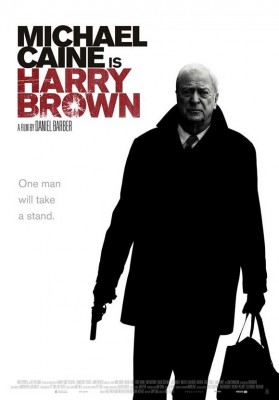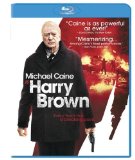| Reviews & Columns |
|
Reviews DVD TV on DVD Blu-ray 4K UHD International DVDs In Theaters Reviews by Studio Video Games Features Collector Series DVDs Easter Egg Database Interviews DVD Talk Radio Feature Articles Columns Anime Talk DVD Savant Horror DVDs The M.O.D. Squad Art House HD Talk Silent DVD
|
DVD Talk Forum |
|
|
| Resources |
|
DVD Price Search Customer Service #'s RCE Info Links |
|
Columns
|
|
|
Harry Brown
It's not entirely clear just what Harry Brown hopes to accomplish; it's neither endorsing nor condemning vigilantism exactly, but rather seems content to present a fictionalized but believable account set in an armpit of a neighborhood, a blight found in most big cities around the world. Ultimately, writer Gary Young and director Daniel Barber appear to be leaving it up to the viewer to decide what to make of Harry Brown and Harry Brown (Michael Caine).
Of course, the big difference between Death Wish and this are the hundreds of vigilante movies, largely cinematic junk, that have been produced in-between. What most critics missed back in 1974 was that Death Wish is a genuinely good movie while its four sequels, though amusing in their own cartoony way, are not. The great irony is that the first Death Wish, if not condemning vigilantism outright, acknowledges that the trauma of killing another human being irreparably harms the moral individual, that moral people and vigilantism are not compatible. In the very last shot of Death Wish, architect-turned-vigilante Paul Kersey smiles like a man possessed as he contemplates his next target, Kersey's unsettling grimace locked in a freeze-frame fade-out. Harry Brown gets around this cleverly and ends quite differently.
A very large percentage of the film's appeal is its star, now Sir Michael Caine, CBE. One of the last movie stars of the 1960s and '70s still top-lining movies in 2010, Caine has a great later-career role, and for his Oscar-worthy performance alone the film is worth seeing, disturbingly violent though it is.
Sony's Blu-ray of the film - shot in high-definition and released in CinemaScope format - looks just fine and the disc includes a wonderful commentary track featuring Caine, whose often hilarious comments make a great digestif to the trauma that is Harry Brown.
Where the violence in Paul Kersey's Manhattan comes in isolated spurts, 70-something pensioner Harry Brown's Elephant and Castle neighborhood, in southeast Inner London, is A Clockwork Orange come to pass, with young punks dealing heroin out in the open, freely accosting female passersby and breaking into residents' automobiles, beating the owners into comas when they protest. In the prologue, a gang initiation is captured via a cellphone video camera, in the graffiti-ridden, River Styx-like underground passageway Harry assiduously avoids. In the video the gangster's initiation includes harassing innocent people, including a mother pushing a pram (baby stroller) who's shot dead right there on the sidewalk.
(Middling Spoilers Throughout) Harry's terminally ill, comatose wife dies early in the film, leaving him a solitary widower. His only child having died at the age of 13 some 35 years before, Harry turns to his frightened friend Leonard (David Bradley) for solace. At a pub run by mutual friend Sid (Liam Cunningham), Leonard shows Harry an old bayonet he's purchased to protect himself from the local hoodlums, who have been terrorizing him day and night. The next morning detectives Frampton (Emily Mortimer) and Hicock (Charlie Creed-Mills) question Harry about Leonard's murder.
Eventually Harry, a former Royal Marine who served in Northern Ireland, decides to take matters into his own hands once it becomes clear the police can do nothing. Though he's old and stricken with emphysema, the unspeakable experience Harry knew "had to be locked away" while he was married is let loose once again. When, late in the film, Frampton tells Harry that, after all, this isn't Northern Ireland, Harry responds, "No it's not. Those people were fighting for something, for a cause. To them out there ... this is just entertainment." He has a point.
Harry's transformation is, as we say in Japan, a case of shoganai, literally "it can't be helped." Short of sitting at home, willing himself to die, Harry has no other option. While the script rightly acknowledges (via police interviews) that the gangsters were raised by neglectful parents, were sexually assaulted as children, etc., as young adults they're all unrepentant monsters with no regard for human life. The film is grimmer, more depressing than Gran Torino, but in its own way more realistic. A curious complaint common among the film's detractors is that it paints the gangsters as one-dimensional, hissable villains. I'm not sure what these critics were expecting, sympathetic drug-dealing murderers perhaps? Shows like The Wire fleshed out these menaces to society, but that doesn't absolve them of the end-stage cancer-like impact they have on their communities.
Harry takes matters into his own hands because he has the skills and hardened heart to do so, and nothing left to lose. In a sense, the film might be likened to Kurosawa's Ikiru as much as Gran Torino, in that like the dying Watanabe of that film, the only validation available to Harry is to drain away the sump. For Watanabe it was ridding the neighborhood of a toxic cesspool, transforming it into a modest children's park. For Harry it's ridding the neighborhood of the drug dealers who so intimidate local residents they, like Harry in the early scenes, dare not use that underground passageway. After all is said and done, the final image of that walkway leading to the pedestrian tunnel almost justifies Harry's actions.
Caine, then 76, gives one of his finest performances, like Eastwood in his last two film roles revealing a vulnerability brought on by fear of losing control of one's environment, and aging generally. It's a subtle yet enormously expressive performance in a film that admirably puts character ahead of its violent set-pieces; he's one of the true stars of the last 50 years - uniquely starring in more great and more awful movies than just about anyone working in films today - and though I hope he does many more plum roles in smaller films like this (rather than slumming through high-concept projects like Bewitched and The Dark Knight), Harry Brown would certainly make an appropriate career-capper.
Indeed, it's a part only Caine and maybe one or two other actors (including Caine's retired pal Sean Connery) could have played. Without explicitly saying so the film harkens back to an earlier era, almost invisibly referencing '60s cinema, such as the opening titles, where "Michael Caine is Harry Brown" in graphics recalling Maurice Binder but in tiny font to underscore Harry's anonymity. (In the audio commentary, Caine expresses mock-outrage over the size of his name in the credits.)
The unusual score is also exceptional, and nearly indescribable, though at times it reminded me of Wendy Carlos's chilling synthesizer music for Stanley Kubrick's The Shining.
Though, depressingly, there always seems to be a crowd that feeds on violent films, no matter how unexplotative, the fact remains that the violence in Harry Brown is in no way glamorized, but shown to be messy, chaotic, and horrifying - no matter who's doing the shooting.
Video & Audio
Filmed in high-definition video, Harry Brown looks fine in its 1080p 2.35:1 'scope aspect ratio, the rain-soaked colors and oppressive florescent lighting, etc. coming off extremely well. Audio is 5.1 DTS-HD is similarly up to contemporary film standards, and supported by English and English SDH subtitles.
Extra Features
Supplements include deleted scenes, also in high-definition, and an audio commentary featuring Caine, director Barber, and producer Kris Thykier. Caine is a treat to listen to while Barber especially goes into considerable detail about the creative decisions throughout the filmmaking process. It's an unusually good track. Interviews and a music video that were part of the UK Region "B" release are not included here, but otherwise the content and transfer appear identical.
Parting Thoughts
This is a difficult, even grueling film to watch - not one I'd encourage Mom and Dad, now about Caine's age, to rush out and rent. But, as Death Wish had done more than a generation ago, it raises moral questions with no easy answers, and Caine delivers another in a half-century of great performances. Highly Recommended.
* Or 1966. One of Caine's early starring roles, as Alfie, included an unnerving illegal abortion sequence that literally made some in the audience ill with horror. It's still pretty shocking today.
Stuart Galbraith IV's latest audio commentary, for AnimEigo's Musashi Miyamoto DVD boxed set, is on sale now.
|
| Popular Reviews |
| Sponsored Links |
|
|
| Sponsored Links |
|
|
| Release List | Reviews | Shop | Newsletter | Forum | DVD Giveaways | Blu-Ray | Advertise |
|
Copyright 2024 DVDTalk.com All Rights Reserved. Legal Info, Privacy Policy, Terms of Use,
Manage Preferences,
Your Privacy Choices | |||||||













